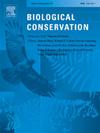Landscape composition can influence reproductive success of plants in semi-natural grasslands depending on their pollinator dependence
IF 4.9
1区 环境科学与生态学
Q1 BIODIVERSITY CONSERVATION
引用次数: 0
Abstract
In a world where insect pollinator declines are a reality, understanding their effects on the reproduction and persistence of wild plant species is vital to contribute to decisions for appropriate conservation strategies. This is especially true in areas which host a high species diversity, like European semi-natural grasslands. In fragmented habitats in particular, pollinator availability can be influenced by surrounding land use, leading to potential cascading effects of land use on plant reproductive success, which is a key factor in wild plant population dynamics. Here, we assess how the proportion of four land-use types (arable land, forest, leys and permanent grasslands) in the surrounding landscape affects pollinator availability and seed set in semi-natural pastures for three plant species varying in pollinator dependence. We found that landscape composition can be connected to the reproductive output of two pollinator-dependent plant species (Lotus corniculatus and Achillea millefolium), and partly to the availability of their pollinators (bumblebees and flies), while a wind-pollinated species (Plantago lanceolata) was less affected. Furthermore, we found that the relationship between pollinator availability and reproductive success can be non-linear, indicating an optimum beyond which plants can be subjected to over-pollination. Pollinator availability and reproductive success were affected in different ways by land-use depending on the plant species. Our results suggest that maintaining and restoring habitat diversity so that landscapes include structural elements like forests as well as extensive land-use types tied to open land will help to support the persistence of the variety of plants that occur in semi-natural grasslands.
在半自然草地上,植物对传粉媒介的依赖性会影响植物的繁殖成功率
在一个昆虫传粉媒介减少的现实世界中,了解它们对野生植物物种繁殖和持久性的影响对于制定适当的保护策略至关重要。这在物种多样性高的地区尤其如此,比如欧洲的半自然草原。特别是在碎片化生境中,传粉者的可用性可能受到周围土地利用的影响,从而导致土地利用对植物繁殖成功的潜在级联效应,这是野生植物种群动态的关键因素。本研究评估了四种土地利用类型(耕地、森林、草地和永久草地)在周围景观中的比例对三种不同传粉媒介依赖性的植物在半自然牧场中的传粉媒介有效性和结实率的影响。研究发现,景观组成与两种依赖传粉者的植物(莲花和千叶阿喀琉斯)的繁殖产出有关,部分与其传粉者(大黄蜂和苍蝇)的可用性有关,而风媒传粉的植物(车前草)受影响较小。此外,我们发现传粉者有效性与繁殖成功之间的关系可能是非线性的,这表明植物可能遭受过度传粉的最佳值。不同植物种类的土地利用对传粉媒介的有效性和繁殖成功率有不同的影响。我们的研究结果表明,维持和恢复栖息地多样性,使景观包括森林等结构元素以及与开放土地相关的广泛土地利用类型,将有助于支持半自然草原中植物多样性的持久性。
本文章由计算机程序翻译,如有差异,请以英文原文为准。
求助全文
约1分钟内获得全文
求助全文
来源期刊

Biological Conservation
环境科学-环境科学
CiteScore
10.20
自引率
3.40%
发文量
295
审稿时长
61 days
期刊介绍:
Biological Conservation is an international leading journal in the discipline of conservation biology. The journal publishes articles spanning a diverse range of fields that contribute to the biological, sociological, and economic dimensions of conservation and natural resource management. The primary aim of Biological Conservation is the publication of high-quality papers that advance the science and practice of conservation, or which demonstrate the application of conservation principles for natural resource management and policy. Therefore it will be of interest to a broad international readership.
 求助内容:
求助内容: 应助结果提醒方式:
应助结果提醒方式:


